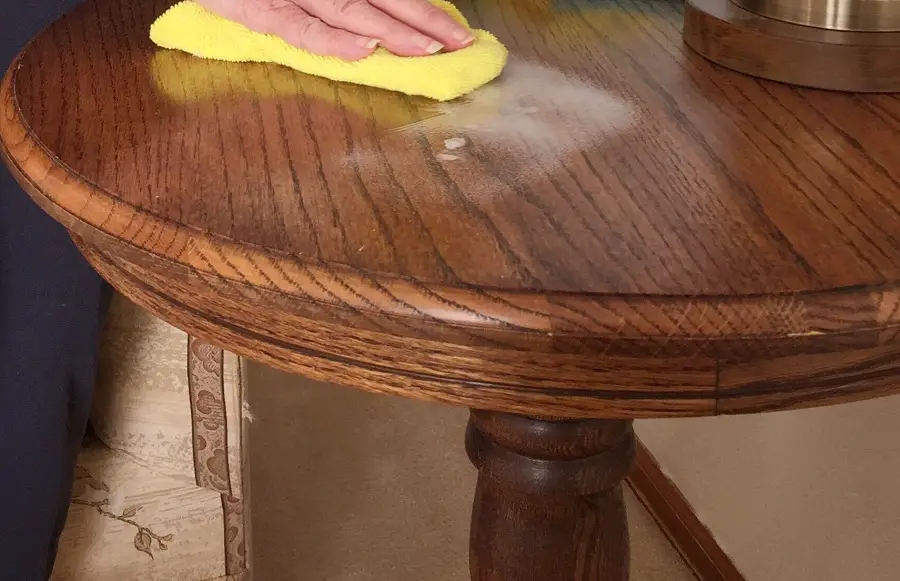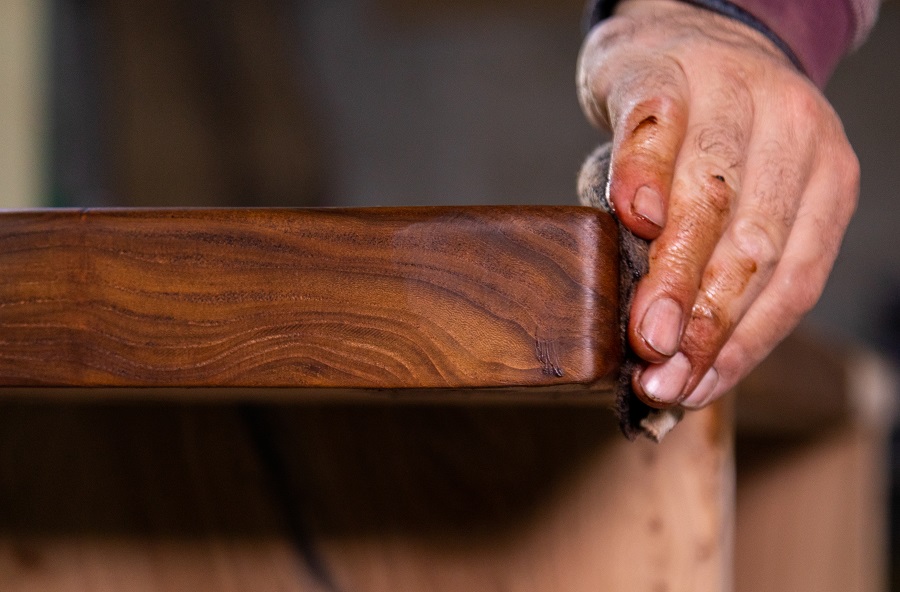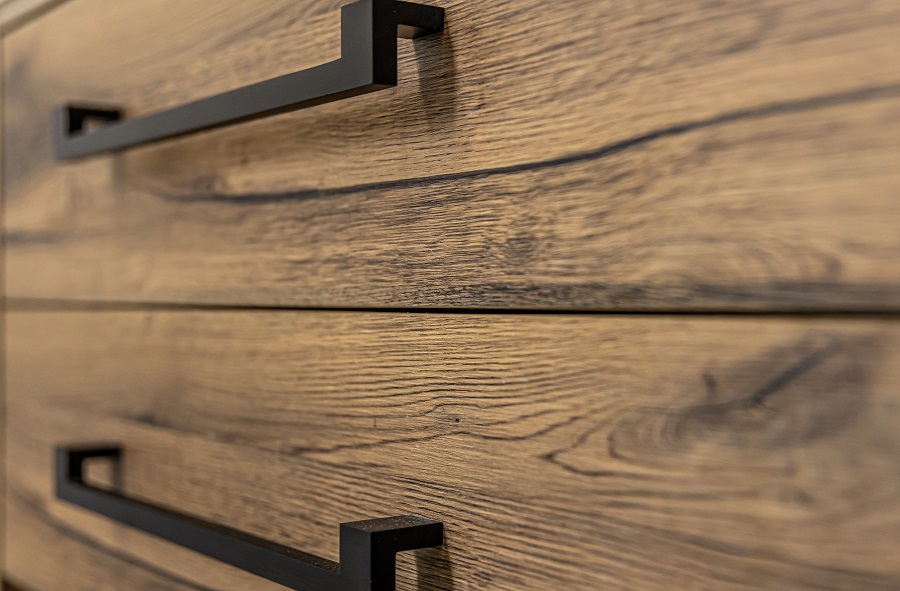"I understand that tung oil is very good. Can I use it to freshen up wooden furniture?"It was a piece of furniture made of varnished wood. Very good, tung oil, but not for wood already varnished. I explained why oil applied over the varnish coat will do nothing to help the wood and recommended using furniture wax, after first cleaning the furniture of dirt accumulated over time. Because wax and oil are often equated, I think a few clarifications are necessary regarding the behaviour of each in relation to wood. It's also good to know that wax can be used to refresh painted or varnished furniture, not linseed or tung oil.

Natural oils are applied directly to the wood - this protects it and enhances its grain
The natural products used to protect wood and finish furniture are oil, wax and shellac-ul. Wax and oil are often mentioned together and therefore there is sometimes confusion about their behaviour towards wood, which is considered similar. Especially as they both protect it from water, one of wood's main enemies.
The oils are applied directly to the wood in order to penetrate as deeply as possible and protect it from the inside. Many say that oil "feeds" wood, and maybe that's not completely wrong, considering that oiled wood retains a fresh, lively look. If oil treatments (boiling) have greatly increased the viscosity of the oil, it is recommended to dilute it with turpentine oil, even 1:1, to ensure that the wood absorbs as much oil as possible. The deeper the oil penetrates, the better the wood is protected and for a longer period of time.
The oil's yellow, sometimes golden-brown colour, oily texture and deep absorption specifically colour the wood and highlight its grain in a unique way. It is virtually impossible to reproduce the effect using stain and varnish and cannot be achieved if the oil is applied over layers of paint or varnish. The look is very natural and because there is no or only a very thin film, the wood retains its natural appearance.

Main differences between linseed and tung oil
The most commonly used natural wood oils are linseed oil and tung oil. Despite their similar appearance, there are differences between them, the most important being their ability to penetrate as far as possible into the wood and their dryness. Linseed oil has a smaller molecule than tung oil and therefore penetrates deeper into the wood, tung oil always needs dilution when applying the first coat.
As for drying, tung oil dries in contact with air, linseed oil does not. Linseed oil, applied in a thicker layer, does not dry out even when boiled and has added siccatives (drying chemicals). After application to the wood and a 20-30 minute soak time, the surface should be wiped to remove excess. If not removed, the excess becomes gummy and sticky, hard to remove and a dirt-causing factor. This is another reason why it is not recommended to apply linseed oil over varnish or paint.
Tung oil polymerises in contact with oxygen in the air, dries and forms a very tough film, even on the outside. However, it is a long process and the film is completely dry 30 days after application. Applying tung oil to a varnished surface is not justified because the wood will not be exposed and the thin layer of oil, even if it dries at some point, will have enough time to fix all the dust in the air. Besides, natural tung oil is expensive, and refinishing old furniture can be done more effectively with much cheaper materials.
Wax protects on the surface and is a solution for refreshing the shine of furniture
Unlike oils, wax is solid and penetrates very little into the wood. For a good adhesion, the wood needs to be rubbed for a long time with a cloth dipped in wax, or the wax needs to be heated beforehand to make it more fluid. The main purpose of waxes is to protect surfaces, including wood, by causing water to run off.
There are many types of waxes used for wood or furniture, ranging from natural waxes such as beeswax or carnauba wax (a type of palm) to paraffin waxes and synthetic waxes. Most commercial waxes are blends, as natural waxes are quite rare and expensive. When they are used to coat wood, linseed oil or synthetic oils, rarely tung oil, are added to the mixture to have a component that goes into the wood, increasing the protection offered.

There are special furniture waxes, which only contain volatile oils such as turpentineto ensure the necessary viscosity of the application. By evaporating the oils, the wax becomes solid, can be polished and thus protects and beautifies the surface with a pleasant silky shine. You can also make your own furniture care wax. Find recipes and instructionshere.
Recommendations for refreshing lacquered furniture
In conclusion, use furniture waxes, not wood oils, to refresh old varnished or painted furniture. Before waxing, the furniture is cleaned of accumulated dirt. The simplest way is to clean it with water and dishwashing detergent. Wipe with a cloth dipped in this solution and wrung out thoroughly. Finally, clean with clean water, again with a well wrung cloth. The water must NOT be allowed to splash. After cleaning, leave the furniture to soak for at least 12 hours, more safely overnight. Then wipe with a soft cotton cloth. After at least 30 minutes, polish with a soft, clean cotton cloth or a piece of felt. The movements are circular at the beginning, along the grain at the end.
I hope you find the information useful. As usual, additions are welcome. And if you have any questions or queries, please leave them in the space below. I'm sure I'll reply.


























Hello,
How long does it take for chestnut wood to dry into a log?
Thickness 30-40 cm
Thank you
Hello!
Chestnut wood dries very slowly. The time can be more than double that of other species. The drying time depends on how much heartwood it has. This means that the older it is, the harder it will dry. This is due to formations in the pores of the heartwood called tiles. that don't let water out. Basically, the tiles clump together in the sectioned area, blocking the water out. It can take more than 6 months, even more than a year, before the moisture reaches 30% (equilibrium moisture). Then the humidity drops even more slowly.
There are specialists who say that cutting 20-25 mm caps (rounds) at the ends every 1-2 months speeds up drying.
The good news is that chestnut wood is very resistant to rot, so there won't be any problems due to high humidity. Beware of insects though, it is not as resistant.